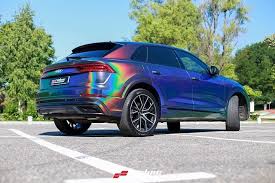
Top Vinyl Wraps Store

|
|

In the quest to personalize and protect vehicles, two popular options often come to mind: vinyl wraps and traditional paint. Among these, Rainbow Vinyl Wrap have gained significant attention for their vibrant, eye-catching appeal. But when it comes to environmental impact, which option stands out as the more eco-friendly choice?
Environmental Impact of Traditional Paint
Traditional automotive paint involves a multi-step process that includes priming, painting, and applying a clear coat. While this method provides a durable and glossy finish, its environmental footprint is considerable. Paint production and application often release volatile organic compounds (VOCs) into the atmosphere. VOCs contribute to air pollution and can pose health risks to workers and nearby residents.
Additionally, the energy-intensive curing process required for traditional paint jobs increases carbon emissions. The disposal of leftover paint and cleaning solvents further adds to environmental challenges, as these substances can contaminate soil and water sources if not handled properly.
The Eco-Friendliness of Rainbow Vinyl Wraps
Vinyl wraps, including rainbow varieties, offer a different approach. These wraps are made from polyvinyl chloride (PVC), a type of plastic. While PVC has its own environmental concerns—such as being non-biodegradable—the application process for vinyl wraps is generally less harmful than that of traditional paint.
Vinyl wraps do not emit VOCs during installation, and the process requires less energy compared to painting. Additionally, wraps can be removed without damaging the underlying surface, making them a temporary yet effective solution for vehicle customization. This reusability can reduce the need for frequent repainting, thereby lowering overall environmental impact.
However, it's important to note that the production of PVC involves chemicals that can be harmful if not managed responsibly. Recycling options for vinyl wraps are also limited, meaning many wraps may eventually end up in landfills.(Vinyl Car Wrap Shop)
Longevity and Maintenance
When considering eco-friendliness, durability plays a key role. High-quality traditional paint can last for decades with proper care, reducing the need for frequent applications. On the other hand, vinyl wraps typically last 5-7 years before needing replacement. While shorter lifespan may seem less sustainable, wraps allow for customization without committing to permanent changes, potentially reducing waste in cases where trends or preferences change.
Conclusion: A Balanced Perspective
Choosing between rainbow vinyl wraps and traditional paint depends on priorities. Vinyl wraps are generally less harmful during application and offer flexibility in design, making them a more eco-friendly option in the short term. However, their reliance on PVC and limited recyclability pose challenges for long-term sustainability.
Traditional paint, while durable, has a higher environmental cost due to VOC emissions and energy-intensive processes. For those seeking a greener alternative, opting for low-VOC or water-based paints could mitigate some of these concerns.
Ultimately, both options have their pros and cons. Consumers looking to make an eco-conscious decision should weigh factors like longevity, customization needs, and disposal methods before choosing the best fit for their vehicle.
White Vinyl Wraps|| Gloss Vinyl Wrap|| Chameleon Wraps|| Rainbow Vinyl Wrap|| Diamond Vinyl Wrap